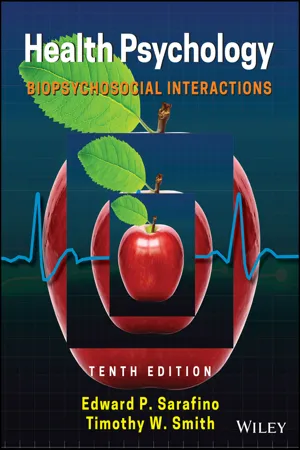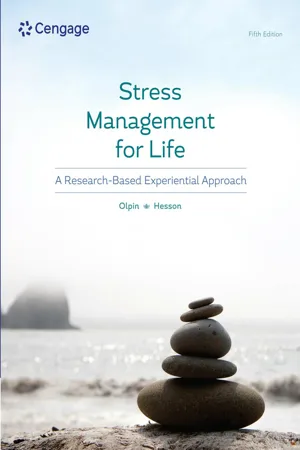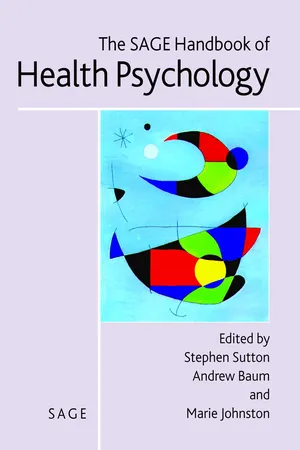Psychology
Measuring Stress
Measuring stress involves assessing the physiological, psychological, and behavioral responses to stressors. Common methods include self-report questionnaires, physiological measures like heart rate and cortisol levels, and behavioral observations. These measures help psychologists understand the impact of stress on individuals and develop effective interventions.
Written by Perlego with AI-assistance
Related key terms
1 of 5
6 Key excerpts on "Measuring Stress"
- eBook - ePub
Job Stress
From Theory to Suggestion
- John M Ivancevich, Daniel C Ganster(Authors)
- 2014(Publication Date)
- Routledge(Publisher)
The choice of particular measures, and the method of administration obviously depend on the nature and goals of the specific study. As we have noted, some of the physiological measurement techniques are more appropriate for studies of response to acute stressors and others are more useful in studies of chronic stress. If one is interested in chronic stress then it is necessary to collect repeated measures of stress over time. The timing and frequency of the assessment should depend upon factors such as whether the stressor is continuous, episodic, or cyclic, the occurrence of other predictable sources of stress such as holiday seasons, and whether one wishes to assess changes in stress response associated with changes in environmental sources of stress. For example, in a study of changes in stress associated with a change in work schedule it would be important to assess stress response both before and after the change. Furthermore, measurements taken immediately pre- or post-change may reflect disruption due to the change itself rather than stress responses associated with the two different schedules. Measures taken two or more weeks before and after the change may more accurately reflect differences due to schedule. If one is interested in chronic stress in a relatively static environment several measures taken over a year or more are probably adequate. In our ongoing studies of chronic stress we measure stress two to four times a year.Comparison groups are essential in the interpretation of any of these measures of stress. Although normative data are available for many of the self-report and physiological measures this seldom provides a useful comparison because the "normal" range is often large, and sample idiosyncracies may bias the results. In addition, stress related elevations in somatic and emotional distress, blood pressure, heart rate, the catecholamines, and corticosteroids, and decrements in behavioral performance are generally still within normal ranges. Therefore, it is important to have a comparable comparison group.We have argued that no single measure of stress should be used alone. Rather, measurement of multiple domains is necessary to evaluate the complexities of the stress response. Stress is not a simple stimulus-response reaction, but instead is a process in which a physical or psychological stressor impinges on an individual, appraisals by the individual, and psychological, behavioral and physiological responses of the individual. Understandably, most behavioral researchers have relied primarily on paper and pencil self-report measures assessing only a few of these domains. However, as interest in the health consequences of stress has increased more researchers have incorporated behavioral and physiological measures into their studies. Assessment of these domains of stress response is important if we are to understand the processes linking stress with health consequences. We have discussed the strengths and weaknesses of the four domains of stress measurement, focusing particularly on the biochemical measures likely to be less familiar to behavioral scientists.Stress Related Health Consequences
Most of the measures described above assess aspects of the stress response itself. Many other biological and health consequences of stress can also be measured. Two responses which may reflect physiological changes resulting from the stress response, and which may more directly mediate specific health consequences are cardiovascular reactivity and immune system function. These are both being measured with increasing frequency in studies of stress consequences. - eBook - PDF
Health Psychology
Biopsychosocial Interactions
- Edward P. Sarafino, Timothy W. Smith(Authors)
- 2021(Publication Date)
- Wiley(Publisher)
Usually the statement means they feel unable to deal with the demands of their environment, and they feel tense and uncomfortable. Because of the pervasiveness and com- monality of these experiences in our lives, you might expect that defining the concept of stress would be simple. But it isn’t. Let’s see how psychologists have conceptualized stress and what the prevailing defini- tion is today. WHAT IS STRESS? The condition of stress has two components: physical, involving direct material or bodily challenge, and psy- chological, involving how individuals perceive circum- stances in their lives (Lovallo, 2005). These components can be examined in three ways (Dougall & Baum, 2012). One approach focuses on the environment: stress is seen as a stimulus, as when we have a demanding job or experience severe pain from arthritis or a death in the family. Physically or psychologically challenging events or circumstances are called stressors. The second approach treats stress as a response, focusing on peo- ple’s reactions to stressors. We see an example of this approach when people use the word stress to refer to their state of tension. Our responses can be psycho- logical, such as your thoughts and emotions when you “feel nervous,” and physiological, as when your heart pounds, your mouth goes dry, and you perspire. The psychological and physiological response to a stressor is called strain. The third approach describes stress as a process that includes stressors and strains, but adds an important dimension: the relationship between the person and environment (Lazarus, 1999; Lazarus & Folkman, 1984). This process involves continuous interactions and adjustments—called transactions—with the person and environment each affecting and being affected by the other. - eBook - ePub
Stress Management
An Integrated Approach to Therapy
- Dorothy H.G. Cotton(Author)
- 2013(Publication Date)
- Routledge(Publisher)
4Assessment of Stress: Tools and Methods
By now, it should be obvious that there are three categories of variables which need to be assessed; these are (1) stressors, including major life events, hassles, and appraisals; (2) the stress reaction, including cognitive, behavioral, and physiological responses; and (3) personal characteristics of the client, including personal resources (strengths and weaknesses), behavior patterns, and coping styles. Measurement of these items is carried out for two reasons. First, problematic areas must be defined so that therapy can be planned appropriately. Secondly, the client's initial status must be clearly identified so that progress can be measured over the course of therapy.MEASUREMENT APPROACHES
There are three approaches to measurement that can be utilized for each variable. First, the item in question may be examined in a general interview format. Second, the item may be assessed through use of rating scales, checklists, or other paper-and-pencil measures. Third, the item may be measured (or observed) directly. Each of these general approaches has its own strengths and weaknesses, and each has its own important role to play in the treatment of the individual client.The Interview
It is difficult to conceive of a therapeutic relationship which does not begin with an in-depth interview between client and therapist. As was stated earlier, basic interviewing skills are as important in the management of stress as they are in any other type of therapy. It is not within the scope of this book to teach such interviewing skills. However, it is worth pointing out the strengths and limitations of the interview format.The interview is the basic means of communication between therapist and client. In a semi-structured interview (i.e., an interview following a general format), the client has the opportunity to state his or her problems and interpretations of them, and to make his or her request for help. The therapist may request information about any aspect of the client's problem, and may pursue any line of thought or interest which arises. Thus, the interview is flexible, usually relatively pleasant, responsive to individual needs and personal styles, and as thorough or in-depth as the interviewer and client wish to make it. The interview is the foundation of any therapeutic relationship. No amount of testing, recording, and measuring will compensate for a poor or incomplete interview. It is generally from the initial interview that all other forms of assessment arise. However, the interview is an incomplete assessment tool. Depending upon the orientation of the interviewer and the comfort of the client, major areas of concern may be overlooked or minimized. The interview process also does not yield a measurable record of the client's status at any point in time. It is difficult to assess change by comparing one interview to another. Interviews are also quite time-consuming; it may take a great deal of time to elicit the amount of detail regarding symptoms and history that is necessary to begin therapy and monitor progress. Interviews are particularly susceptible to social desirability and expectancy biases. Thus, essential as it may be, the interview is not a sufficient measure for planning and evaluating therapy. Some of the limitations of the interview may be overcome by using a structured interview format, but at the same time, such a structure reduces the interview's flexibility, one of its major advantages. - eBook - ePub
- Maureen Dollard, Helen R. Winefield, Anthony H. Winefield, Maureen Dollard, Helen R. Winefield, Anthony H. Winefield(Authors)
- 2003(Publication Date)
- CRC Press(Publisher)
CHAPTER THREE Measurement and Methodological Issues in Work Stress Research Maureen F. Dollard and Jan de Jonge3.1 INTRODUCTION
A renaissance of interest in measurement and methodological issues in work stress research is emerging as researchers, managers and policy makers seek gold standards in its evidence base for policy and practice. Increasingly cost–benefit analyses of work stress/interventions are sought and there is growing recognition that health and well-being measures are a quintessential component of organisational performance analysis. The aim of this paper is therefore to review both measurement and research design issues. As will be seen in the following discussion, the issues are inextricably linked. Moreover, each of the major models of work stress requires different measurement procedures. The issues raised are relevant to both theory – and problem – driven research. The implications of these issues are widespread, for consumers of research, those who attempt to measure risk in the work environment, and for those who attempt to implement change, develop policy, or manage injury.3.2 CONCEPTUAL FRAMEWORKS
Work stress research in general attempts to draw links between taxing aspects of the work environment (demands, stressors), perceptions and appraisals of these, and manifestations of strain including physiological, psychological, and behavioural changes that may result (Baker, 1985; Greenhaus and Parasuraman, 1987). Despite ‘work stress’ being used in an enormous number of research articles, researchers have still not reached agreement on the meaning of this concept (Hart and Cooper, 2001). Moreover, different conceptualisations of work stress give rise to important and complex measurement issues in research. To illustrate this point we will focus here on two dominant paradigms of thinking in the field. The first is the psychological paradigm, where stress is described as a relationship between the person and the environment that is appraised as taxing or exceeding resources, and endangers well-being (Lazarus and Folkman, 1984). The second paradigm consists of so-called situation-centred theoretical models, where stress - eBook - PDF
Stress Management for Life
A Research-Based Experiential Approach
- Michael Olpin, Margie Hesson, Michael Olpin(Authors)
- 2020(Publication Date)
- Cengage Learning EMEA(Publisher)
Self-Assessment A life unexamined is a life wasted. —Socrates I know I feel stressed, but how can I measure my stress? How do I rate my stress level compared to the stress level of others? When I feel stressed, is it more because of what is happening in my life or because of how I react or think about what is happening? I often have headaches and tight shoulders, but I am not sure why. Could this be due to stress? Study of this chapter will enable you to do the following: 2.1 Assess your current level of stress from a variety of perspectives. 2.2 Explain the physiological and psychological indicators of stress. 2.3 Evaluate the impact of stress on the quality of your life. Learning Objectives 2 chapter Red Chopsticks/Getty Images Copyright 2021 Cengage Learning. All Rights Reserved. May not be copied, scanned, or duplicated, in whole or in part. Due to electronic rights, some third party content may be suppressed from the eBook and/or eChapter(s). Editorial review has deemed that any suppressed content does not materially affect the overall learning experience. Cengage Learning reserves the right to remove additional content at any time if subsequent rights restrictions require it. 16 Chapter 2: Self-Assessment Stress Happens The Stress Management 101 class was about to begin. Today’s topic was “Assessing Your Stress.” Angie sat quietly in the back of the classroom. “Okay class, let’s start by checking our resting heart rate,” the teacher announced. Angie’s pulse was 105 beats per minute. “Next, check the number of breaths you take per minute.” Angie counted 30 breaths. “How long does it usually take you to fall asleep once you lie down at night?” Angie said she usually takes at least an hour. “How much of the time do you feel high levels of stress?” Angie said she feels that way almost all the time. “Doesn’t it feel unpleasant always to feel so stressed?” the teacher questioned. - eBook - PDF
- Stephen Sutton, Andrew Baum, Marie Johnston, Stephen Sutton, Andrew Baum, Marie Johnston(Authors)
- 2004(Publication Date)
- SAGE Publications Ltd(Publisher)
Psychological processes are involved in the process of obtain-ing measurements. People may behave differ-ently when they are observed, they may have psychophysiological responses to the process of measurement, and they may be actively trying to solve the problem of how to complete a questionnaire, respond to an interview or participate in other assessment procedures. Reactivity to measurement may be of partic-ular importance in health psychology. For example, the process of observing behaviours THE SAGE HANDBOOK OF HEALTH PSYCHOLOGY 368 may increase adherence, lead to exaggerated pain behaviours or reduce the frequency of health damaging behaviours. In psychophysio-logical assessments, it is widely recognized that heart rate, skin conductance and other mea-sures of sympathetic arousal will be raised by the initial process of measurement and investi-gators routinely incorporate a period of habit-uation before using measures obtained. In assessments involving self-presentation or report, the individual may be concerned about the consequences of how they present: for example, minimizing symptoms or health problems may reduce access to treatment, whereas a true presentation may be too chal-lenging for the individual’s coping resources. The following sections describe some com-mon measurement issues resulting from measurement reactivity. Survey cognition: how respondents tackle questionnaires Schwarz (1999) describes a number of effects attributable to the response of the individual to the survey or questionnaire context. A number of models of ‘survey cognition’ have been developed which aim to describe how people approach the task of completing a question-naire. These models tend to have three core stages ( Jobe & Herrmann, 1996): input, medi-ation, and output, each with different oppor-tunities for error of measurement.
Index pages curate the most relevant extracts from our library of academic textbooks. They’ve been created using an in-house natural language model (NLM), each adding context and meaning to key research topics.





